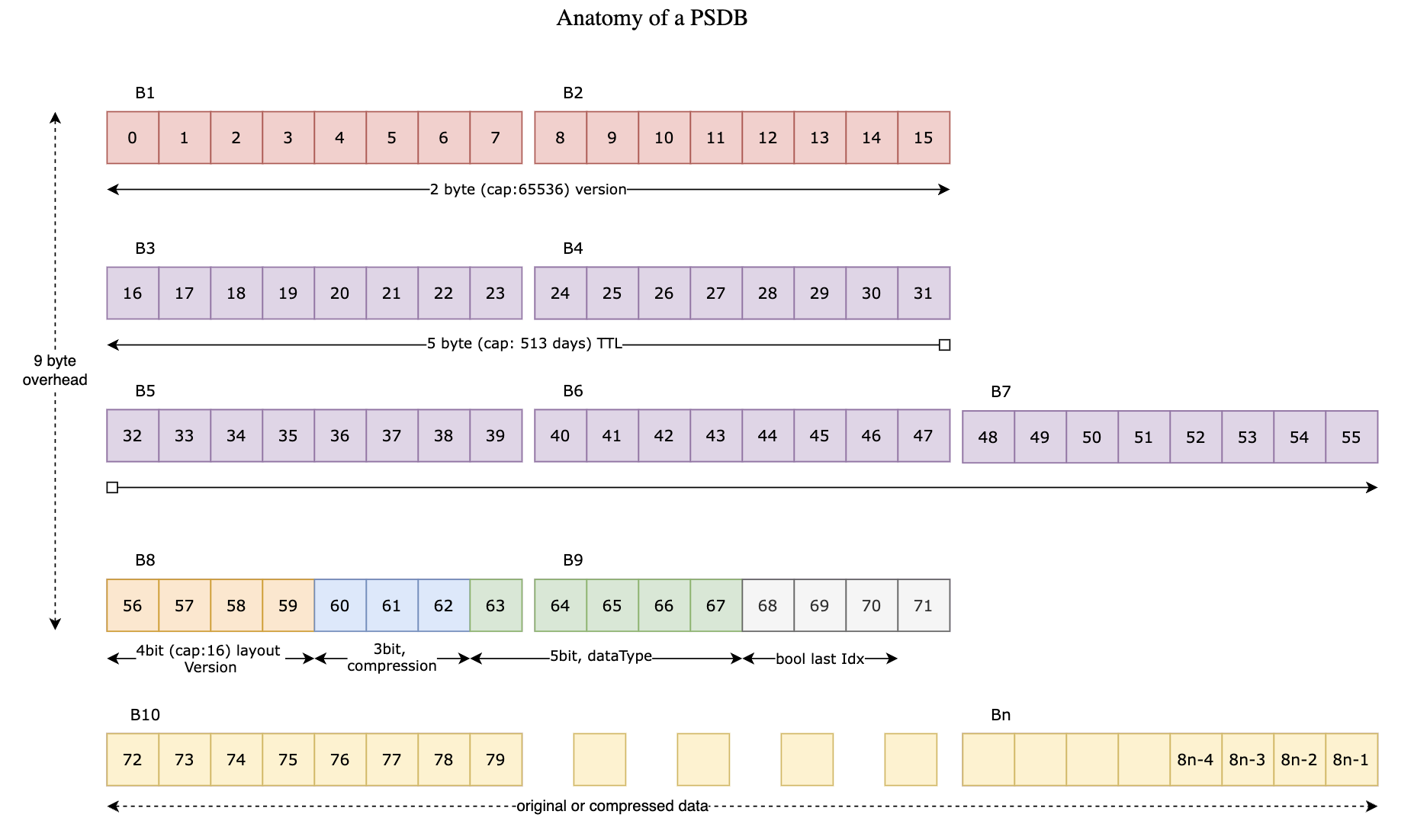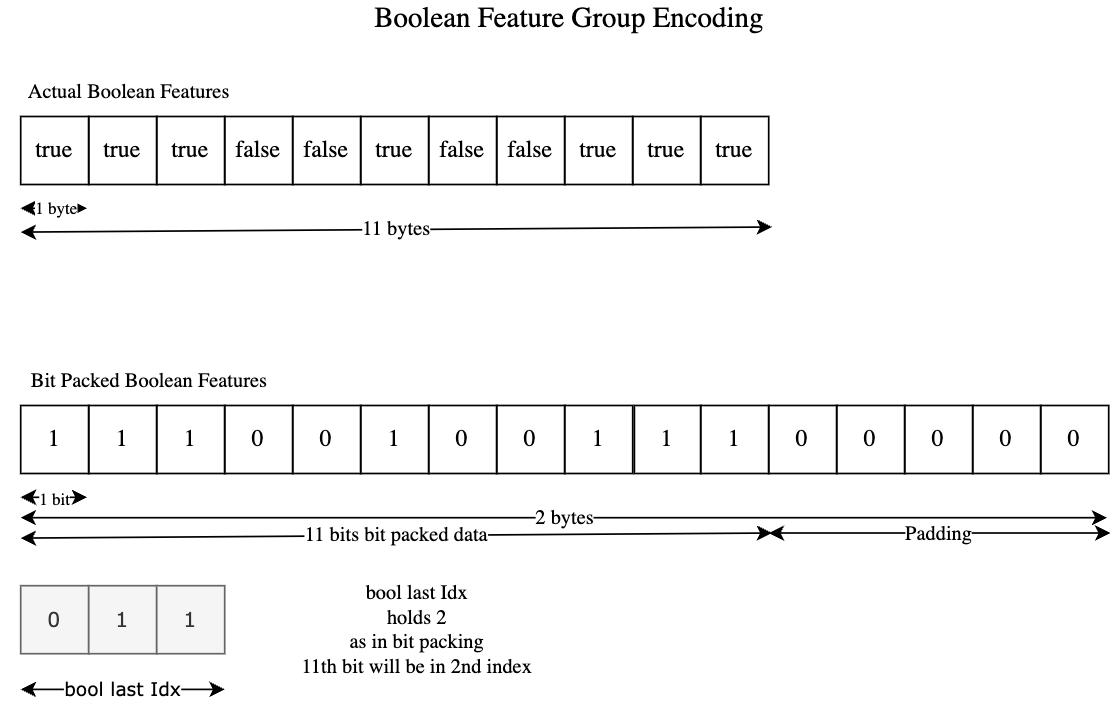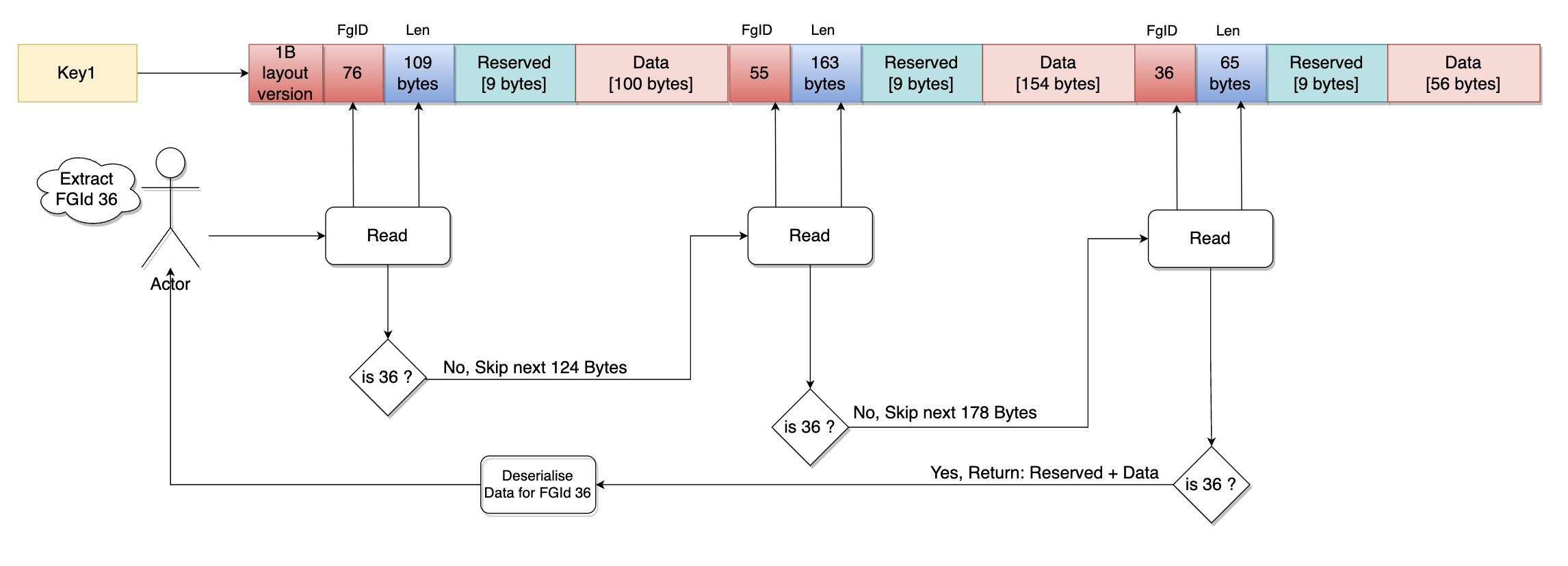Data Format for Permanent & Cache Storage
In this section we will go through the data-formats which is at the hear of online-feature-store, it's inspired form other storage efficient formats like parquet & arrow, but custom made to deliver in constraint environment. The two key data-formats are:
- PSDB - Permanent Storage Data Block used wile storing data in ScyllaDB
- CSDB - Cache Storage Data Block used while storing data in DragonflyDB or Redis, optimal for KV
PSDB (Permanent Storage Data Block) Format
The PSDB format is a compact, versioned, and schema-aware binary layout used to store feature groups efficiently for ML inference. It supports multiple datatypes (strings, booleans, fixed-size vectors), versioning, TTL, and metadata encoding in a compact header.
🧱 Structure Overview
Each PSDB block is composed of multiple byte sections:

| Byte | Bits | Field | Description |
|---|---|---|---|
| 0-1 | 0-15 | Feature Schema Version | Version for tracking schema changes (additions/deletions) in feature group |
| 2-6 | 16-55 | Expiry Timestamp | Encoded as a compact representation, ~513 days max |
| 7 | 56-59 | Layout Version | Used to ensure backward compatibility with layout format changes |
| 7 | 60-62 | Compression Type | 3-bit field specifying compression algorithm |
| 7-8 | 63-67 | Data Type | 5-bit field split across bytes 7 and 8 |
| 8 | 68-71 | Bool Last Valid Bit | 4-bit field for last valid boolean bit |
Supported Data Types
Scalar Types
| Type | Container | Size | Description |
|---|---|---|---|
FP32, FP16, FP8E4M3, FP8E5M2 | []float32 | 4/2/1/1 bytes | Floating point numbers |
Int32, Int16, Int8 | []int32 | 4/2/1 bytes | Signed integers |
Uint32, Uint16, Uint8 | []uint32 | 4/2/1 bytes | Unsigned integers |
FP64 | []float64 | 8 bytes | Double precision float |
Int64 | []int64 | 8 bytes | 64-bit signed integer |
Uint64 | []uint64 | 8 bytes | 64-bit unsigned integer |
String | []string | Variable | Pascal-style strings |
Bool | []uint8 | Bit-packed | Boolean values |
Vector Types
| Type | Container | Description |
|---|---|---|
FP32Vector, FP16Vector, etc. | [][]float32 | 2D slices of floating point |
Int32Vector, Int16Vector, etc. | [][]int32 | 2D slices of signed integers |
Uint32Vector, Uint16Vector, etc. | [][]uint32 | 2D slices of unsigned integers |
FP64Vector | [][]float64 | 2D slices of doubles |
Int64Vector | [][]int64 | 2D slices of 64-bit signed |
Uint64Vector | [][]uint64 | 2D slices of 64-bit unsigned |
StringVector | [][]string | 2D slices of strings |
BoolVector | [][]uint8 | 2D slices of bit-packed bools |
📦 Encoding for Scalar Feature Type
1. 🔡 String Feature Group (Variable Length Encoding using Pascal)
- Max string length: 65536
- Format:

- Deserialization:
- Read length prefixes
- Extract string bytes using
StrLenX
2. 🟩 Boolean Feature Group (Bit-Packed)
- Saves space using bit-level packing.
- Encoding:
- Raw: 1 byte per feature
- Bit-packed: 1 bit per boolean
- Additional index (
bool last idx) stores where the last bit resides
- Format:

3. 📏 Fixed-Length Feature Group
- For fixed-size vectors (
nbytes each) - Format:

- Efficient for dense numeric features like float32, int64, etc.
4. Compression
TypeNone (0): Raw storageTypeZSTD (1): Compressed using Zstandard
Compression is opportunistic. During serialization, if compressed size is not smaller, PSDB falls back to uncompressed format. It keeps the read/high througput path use less CPU cycles. Also only data part of PSDB is compressed allowing decompression only if block has a valid TTL
🧬 Encoding for Vector Types
Conceptual Overview
PSDB encodes vector data by flattening multi-dimensional arrays into a single contiguous byte buffer while preserving the ability to reconstruct the original vector boundaries.
Vector Length Metadata
Each feature group maintains metadata about vector dimensions in the Feature Registry. For example, if a feature group has:
fg1:
version-2:
features:
f1: { vector_len: 6, default: [bytes] }
f2: { vector_len: 3, default: [bytes] }
version-1:
features:
f1: { vector_len: 6, default: [bytes] }
- Feature f1 with vector_len: 6
- Feature f2 with vector_len: 3
This means:
f1contains vectors of exactly 6 elements eachf2contains vectors of exactly 3 elements each
Encoding Process
Input Structure
The serializer receives vector data as 2D slices where:
- Outer dimension represents different feature instances/entities
- Inner dimension represents the vector elements for each instance
Length Validation
Before encoding, PSDB validates that each vector's actual length matches the declared vector_len from the feature metadata. This ensures data integrity and enables efficient decoding.
Flattening Strategy
Vectors are serialized in row-major order (also called C-style order):
- All elements of the first vector are written consecutively
- Followed by all elements of the second vector
- And so on...
Contiguous Layout
The resulting byte buffer contains all vector elements placed end-to-end without gaps or separators. The decoder can reconstruct vector boundaries because it knows:
- The data type size (e.g., 4 bytes for float32), from feature registry
- The vector length for each position, from feature registry
- The total number of vectors, from feature registry
- In case of
variable lengthlength is encoded into the data, like forStringdata-type
🔄 Deserialization/Decoding Flow
- Extract version from first 2 bytes.
- Look up schema from etcd using the version.
- Determine feature shapes (e.g., vector lengths).
- Slice and decode data from byte buffer accordingly.
Memory Efficiency Benefits
- No Padding: Elements are packed tightly without alignment padding
- No Delimiters: Vector boundaries are implicit, not stored explicitly
- Cache Friendly: Sequential memory access patterns during encoding/decoding
- Minimal Metadata: Only vector lengths are stored separately, not per-element
Cache Storage Data Block (CSDB) Design
Overview
The Cache Storage Data Block (CSDB) is a compact binary data format that encapsulates serialized data blocks for multiple feature groups. It is designed to support both in-memory and distributed caching of deserialized PSDB (Permanent Storage Data Block) content, optimizing for speed, deduplication, and minimal memory overhead.
Structure and Purpose
Each CSDB contains a mapping of feature group IDs (FG IDs) to deserialized PSDBs. For distributed systems, this structure is flattened into a serialized byte slice. The CSDB supports layout versioning for backward compatibility and negative caching for feature groups with no associated data.
Core Fields and Memory Layout
type CacheStorageDataBlock struct {
// 8-byte aligned map pointer
FGIdToDDB map[int]*DeserializedPSDB // offset: 0
// 24-byte slice (ptr, len, cap)
serializedCSDB []byte // offset: 8
// 4-byte fields
TTL uint32 // offset: 32
// 1-byte fields
layoutVersion uint8 // offset: 36
cacheType CacheType // offset: 37
// 2 bytes padding to maintain 4-byte alignment
}
The structure is memory-aligned for optimal performance:
- Pointers and slices are 8-byte aligned
- Smaller fields (like
uint8) are grouped and padded to avoid false sharing - This layout ensures efficient use of CPU caches during access
Cache Types
- In-Memory Cache: Uses the
FGIdToDDBmap directly and avoids serialization unless explicitly requested. - Distributed Cache: Stores a serialized binary format in
serializedCSDB, which is deserialized lazily when required.
Format & Encoding
CSDB Binary Layout: Serialized CSDBs follow this compact format:
[LayoutVersion (1 byte)][FGID (2 bytes)][DataLen (2 bytes)][Data ...] → repeated per feature group
- FGID and DataLen are encoded as
uint16 - If
DataLen == 0, it denotes a negative cache (no data available for that FG) - The data section contains the PSDB header and either compressed or uncompressed data
This layout allows fast scanning and partial deserialization for selected FG IDs, making it optimal for large-scale caching systems.
Differences Between In-Memory and Distributed Caching
| Aspect | In-Memory CSDB | Distributed CSDB |
|---|---|---|
| Storage Format | Live Go objects (map[int]*DeserializedPSDB) | Serialized byte buffer ([]byte) |
| Deserialization | Performed on-demand using offset map | Performed on-demand using offset map |
| Compression | Optional during serialization | Typically enabled to reduce payload size |
| Usage Pattern | Fast lookup in active process memory | Cross-node cache sharing and persistence |
| Memory Overhead | Higher (due to live objects) | Lower (compact representation) |
Optimizations & Features
- Partial FG ID Fetch: When only a subset of FG IDs is needed, CSDB avoids unnecessary deserialization of other IDs.
- Negative Caching: FG IDs with no data are encoded with
DataLen=0, saving space and avoiding repeated lookups. - Offset-Length Map: During deserialization, FGID to offset+length pairs are cached internally for efficient random access.
- Versioning Support: Layout version is stored as the first byte to enable format upgrades while maintaining backward compatibility.
Diagram below explains how compute cycles are saved by partial de-compression.
